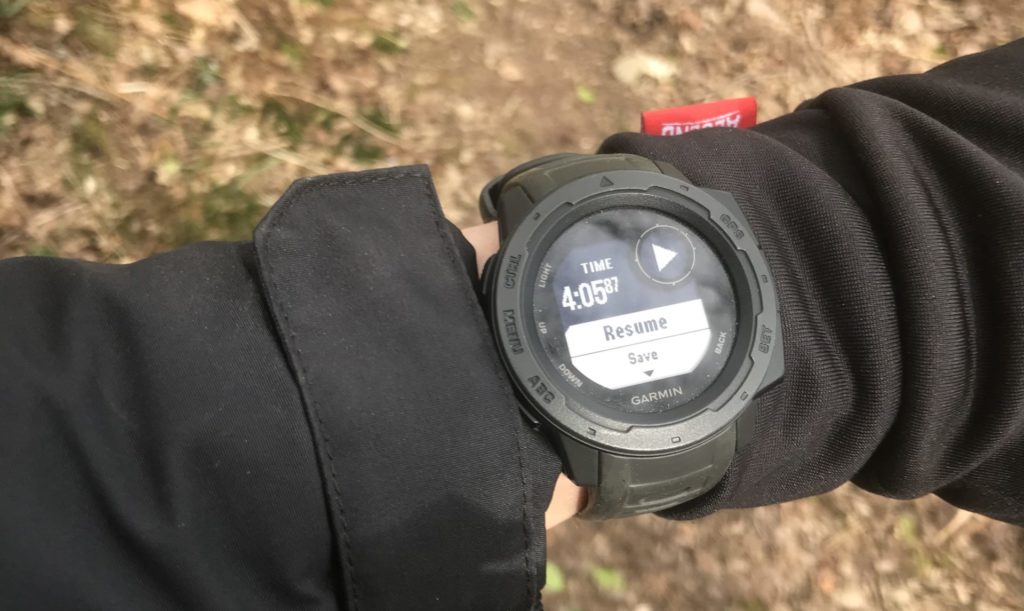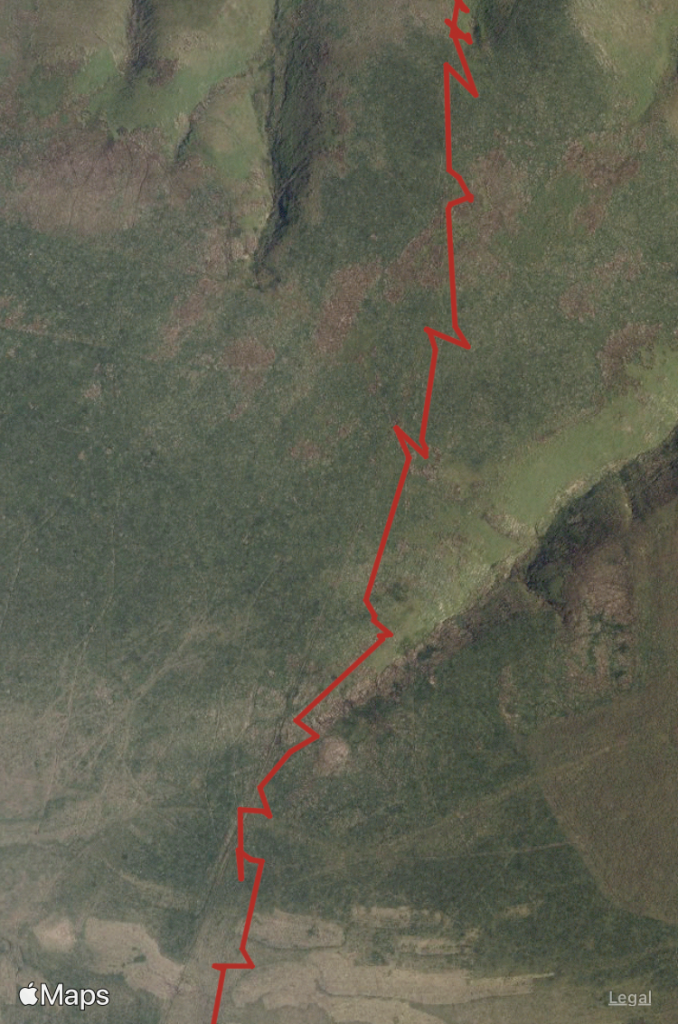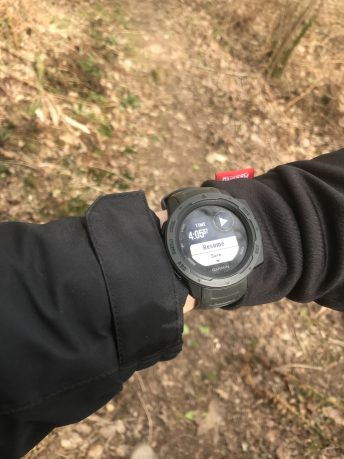
The Garmin Instinct is a fantastic GPS-Smartwatch that I use all the time for any number of things. It is packed with many excellent features.
 (5 / 5)
(5 / 5)
The Bottom Line
- Excellent watch
- Rugged, ‘G-Shock’ design
- Military Standard 810 thermal, shock & water resistance
- 100m water resistant
- Battery:
- Smartwatch Mode: 2 weeks (usually a bit less)
- GPS mode: up to 16 hours (more like 12-14)
- UltraTrac: up to 40 hours
- Notifications from phone
- Extra features with accompanying phone apps
Types
There are two types of Garmin Instinct available:
| Features | Price (direct from Garmin) | |
| Garmin Instinct | As discussed below | £240 |
| Garmin Instinct Tactical | As below, plus: – Stealth Mode: GPS locations aren’t stored or shared – Night Vision Mode: Reduces screen brightness not to interfere with night vision goggles – Jump Master: Used for skydiving. -Dual Coordinates: Display grid references, as well as GPS coordinates. | £280 |
What I have, and the one I’ll be reviewing here, is the regular Instinct.
Purchasing
The Instinct is available direct from Garmin, as well as on Amazon. It normally goes for between £200 and £300.
Instinct Features
This watch is packed full of everything you could need from an all-round outdoor watch. I will explain each of these a little more.
Hardware Features
- Wrist-based heart rate sensor
- Barometric Altimeter
- Barometer
- 3-axis compass
- Temperature sensor
- Cadence sensor
- GPS/GLONASS/Galileo compatible
Heart Rate Sensor
Garmin’s Elevate optical wrist-based heart rate sensor has been very reliable. Occasionally it over-measures and I have to restart the watch, but only once or twice in the last six months. It copes well with water and gives accurate readings, even during activities like running which inevitably shake it around a bit. I am very pleased with this aspect of the watch. For some, Elevate may not be accurate enough, but the Instinct is compatible with any ANT+ external sensor.
ABC Sensors
The ‘ABC sensors’ are the altimeter, barometer and compass:
Altimeter
The altimeter is easily thrown by water – it cannot deal with the shower or swimming. Because it is barometric, it can also vary over time, although not significantly. Occasionally, when I’ve been in the same place for a few hours, it will register a change in altitude that didn’t happen – but not more than a few meters.

Barometer
The barometer supplies data to the altimeter, but itself is accurate (as far as I can test). The watch offers you a ‘Storm Alert,’ which warns you about a possible storm. The way it does this is by measuring change in pressure, so it occasionally triggers by mistake (e.g. on a plane) but is often very good.
Compass
The compass is a fantastic feature to have on this watch. It is accurate and makes taking bearings easy, and is quick to access. It can be calibrated easily by moving the watch in a small figure of eight, and you can set the north reference to true, magnetic or grid north.
Temperature Sensor
The temperature sensor, while accurate, is all but useless to me. It measures the temperature on my wrist, which is neither body temperature nor ambient temperature. It’s some strange hybrid. When not wearing the watch, it provides accurate ambient temperature – but its a watch. So I wear it.
Cadence Sensor
In my use of the watch (for hiking and trail running), I’ve come across the cadence sensor only for run cadence, measured in steps per minute. I don’t find it the must useful of metrics, but it is good to know.

GPS/GLONASS/Galileo Compatibility
This is a fantastic feature. It means that the watch can locate itself not only with GPS satellites (USA), but with Russian GLONASS or ESA Galileo satellites too. This makes location finding far faster – but uses more power. Occasionally, even with all three of these, the watch can take a few minutes to locate you. This depends hugely on location: in my experience it is far slower in towns and cities.
Software Features
The Instinct’s impressive sensor collection allows it to do an even more impressive range of things. I’ve chosen these features as the ones I use the most, for hiking, backpacking and trail running. A complete list of features is available on Garmin’s website.
- UltraTrac activity tracking for increased battery life
- Multi-sport tracking
- Back to Start: navigate back to start point
- Sleep tracking
- Activity intensity tracking
- Sun rise & set times
- Moon phase, rise and set times
- Steps taken
- Flights climbed
- Weather forecasting (requites phone connection)
Many of these features are fairly self explanatory, and all work well. I will explain the two less obvious ones:
UltraTrac
I personally never use UltraTrac, because it isn’t particularly good. The tracks it produces are very shaky and it makes it impossible to follow a course. It is a great feature if you are doing a single, long activity, but I tend to use normal GPS and just carry my mini OMARS portable charger to top it up in the evenings – 14 hours on GPS mode is enough for any activity I do.

Back to Start
When I’m using the watch to help with navigation, Back to Start is a fantastic feature to have. I don’t use it that much, but it can be really helpful if I get off course. In Back to Start mode, the watch will guide you back along the way you came. Once I get back to the path I’m supposed to be on, I can switch back to tracking mode and continue. Back to Start is a function that makes it almost impossible to get completely lost – provided your watch is in GPS mode and has battery.
When I’m using the watch to help with navigation, Back to Start is a fantastic feature to have. I don’t use it that much, but it can be really helpful if I get off course. In Back to Start mode, the watch will guide you back along the way you came. Once I get back to the path I’m supposed to be on, I can switch back to tracking mode and continue. Back to Start is a function that makes it almost impossible to get completely lost – provided your watch is in GPS mode and has battery.

Thoughts
I’ve had my Garmin Instinct for seven months now, and in that time I’ve hardly taken it off. I use its activity tracking features almost daily (outside Lockdown at least), and I’ve found it to be very accurate – as long as I’m not using UltraTrack. UltraTrack does, of course, have its uses, but not form me, as I’ve discussed.
For what I need, the Instinct is perfect: I use it for hiking, expeditions, and trail running (I’ve also used it occasionally for cycling, but not enough to comment). For my three uses, it does everything I need and some, and it’s good to know that its navigational use could really help in an emergency situation: even the regular version (which is what I have, not the ‘Tactical’ one) can give you your exact coordinates. These could be very helpful in letting emergency services know where you are.
Conclusions
This has been a fairly brief review simply because, other than the few points I’ve mentioned, I really can’t fault this watch. It has a lot of features, many of which I don’t use too much, but they all have their function and work extremely well.
Using Garmin Connect, it is very easy to upload GPX routes to the watch and then to follow them, and I find this a fantastic feature. Using Garmin Explore, Garmin’s second app, it is even possible to plan routes in-app – but even so, the mapping is not particularly good. Usually, I just to use the OS Maps app to plan my routes.
A final conclusion, then:
The Garmin Instinct is a phenomenal watch, and cheaper than many comparable devices. That being said, it does cost over £200 which isn’t nothing, but I would say that it is absolutely worth it.

